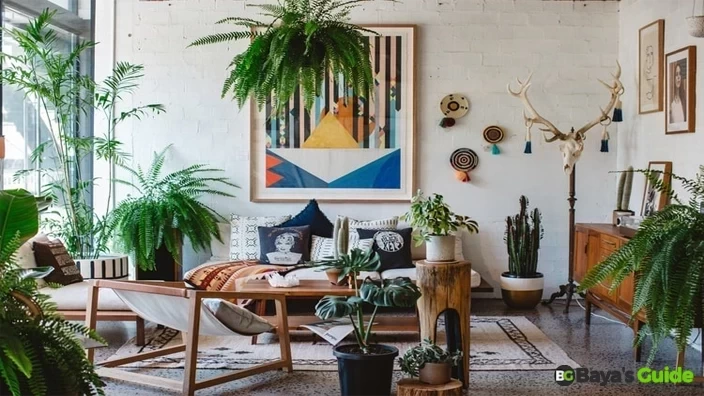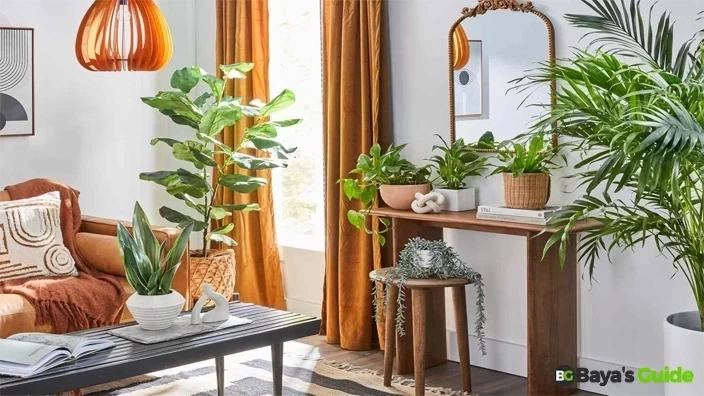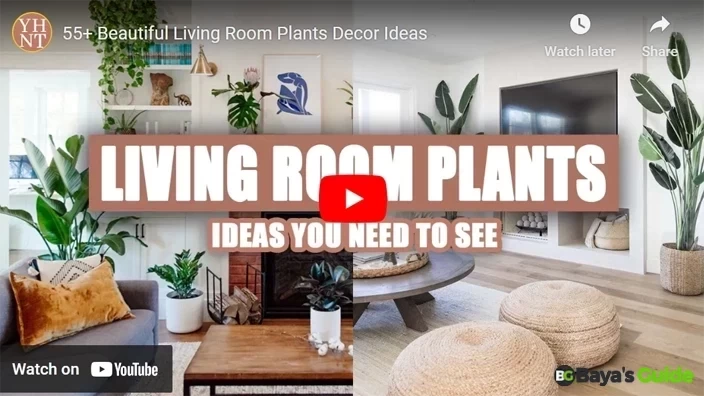Changing your home into a green oasis soothes you and also improves the decor of your surroundings. Plants are like natural magic that seem to infuse life and energy into the room. They give a sense of unity between the indoors and the wild. To truly make your space shine, you need to master the art of how to arrange plants in the living room.
Imagine how you feel when you enter your living room and see lots of green shades, which serve as a natural remedy for the monotony of the concrete world outside. Plants are not simply air purifiers but also mesmerizing natural décor elements, creating a retreat of peacefulness in your living room. If you're new to this and don't know How To Arrange Plants In Living Room, just relax! Our guide is so easy that even beginners can follow it.
Table of Contents
- 10 Effective Ways For Arranging Plants In Living Room
- 1- Follow Feng Shui Principles To Place Plants
- 2- Group Plants In Clusters
- 3- Arrange Plants According To Their Height
- 4- Place Plants In Adequate Light
- 5- Choose Plant Size According To Your Space
- 6- Don't Rely On One Color Of Plant
- 7- Use Empty Corners For Plant Decoration
- 8- Opt For Decorative Plant Pots
- 9- Add Some None Botanicals Along With Your Plants
- 10- Use Space Saving Techniques To Accommodate Plants
- Tips To Arrange Plants In Living Room
- Frequently Asked Questions
- How To Arrange Plants In Bedroom?
- How To Arrange Plants Outdoor?
- What Is The Best Way To Arrange Plants In Your Home?
- How Do You Display Plants In A Living Room?
- Where Is The Best Place To Put Plants In The Living Room?
- How Do You Put Plants In A Small Living Room?
- What Is The Best Layout For Plants?
- How Many Plants Should Be In A Living Room?
- Conclusion
10 Effective Ways For Arranging Plants In Living Room
Learning how to arrange plants in the living room is a no-brainer when you know the right tips and tricks. Below are some of the most effective strategies you can use to adorn your living room with plants:
1- Follow Feng Shui Principles To Place Plants
One great way to bring some nature into your living space is by following the feng shui and how to arrange indoor plants guide. According to this practice, it's best to put your plants in spots with natural elements such as wood, fire, and water.
Moreover, it suggests that your living area's east, south, and southeast corners are fantastic places to position your plants.
This arrangement can help draw in prosperity, improve your well-being, and bring many other positive vibes to your living room. Now, you might be wondering how such a small placement can impact your luck. Well, when you put plants in the southeast or any feng shui direction, their wood element nourishes the fire element. This, in turn, can bring more opportunities for flourishing in your life.
2- Group Plants In Clusters
Whenever you ask an indoor plant enthusiast how to taller plants, they will always suggest odd clusters. An even number of plants presents a very formal and uninterested look. For this reason, it is often advised to stack them in odd numbers like 3, 5, 7, or 9. You can arrange an odd number of plants at different heights to create a striking visual effect.
3- Arrange Plants According To Their Height
When you're thinking about grouping plants, one crucial factor to consider is organizing them by their height. You can't simply put the tall plant right in front because it's the biggest. If you are successful in placing tall plants, your room will look quite strange.
To create an attractive arrangement of plants, try grouping them in an ascending manner. Put the shorter or smaller indoor plants at the front and the larger or taller ones at the back. This not only enhances the beauty of your living room but also ensures that each plant receives sufficient light.
You Might Be Interested:How To Tell If A Dog Has Fleas
4- Place Plants In Adequate Light
Yes, indoor plants also need light to thrive, and when not provided the right amount of sunlight, they can deteriorate rapidly. So, when considering the arrangement of plants in your living room, selecting a spot that receives an adequate amount of sunlight is essential.
5- Choose Plant Size According To Your Space
Often, while deciding how to arrange trailing plants in a living room that's spacious enough, you don't have to worry about the available space. For example, if you have a huge living room, you can have those extra huge steel planters in your living room's corner.
However, if you are wondering how to arrange smaller plants in a small living room, investing in compact planters is essential.
6- Don't Rely On One Color Of Plant
To make your room more attractive, try mixing it with indoor, outdoor, or other plants of different colors, leaf shapes, and textures. So, you have to choose plants wisely.
Using the same plants can make things look uninteresting. You can discover houseplants with vibrant colors like red, striped, or even purple.
7- Use Empty Corners For Plant Decoration
If there's an empty corner in your room, and you're not sure what to do with it, think about placing indoor plants there. You can use a plant stand and Fiddle Leaf Fig for this purpose. This is a common and effective way to arrange plants in a living area.
8- Opt For Decorative Plant Pots
Your living room is the area of the house that reflects your personality. Decorative plant pots allow you to express your unique style and individuality. On the other hand, if you are more into decent aesthetics, you can choose elegant and simple designs.
But here's another idea: you can also use decorative terrariums to organize your plants in your room. These are stylish plant organizers that you can hang or place on shelves and tables.
9- Add Some None Botanicals Along With Your Plants
To take your indoor plant game to the next level, consider incorporating some non-botanical decorations. A fantastic way to do this is by combining your real plants with fake plants. While selecting fake decorative plants for your living room, opt for the ones that actually complement your real plants. For instance, if you have succulents, consider artificial succulents in a different color or texture to enhance the original ones.
10- Use Space Saving Techniques To Accommodate Plants
If you are running out of space and always thinking about arranging hanging plants in a small room, then we've got solutions for you. Firstly, if you don't have any space on the floor, you can turn to vertical solutions to incorporate plants into your living area.
You can do so by installing floating shelves or wall-mounted planters. However, if you are not into drilling holes into your walls, do consider small and compact plants like succulents or herbs. These plants can easily find a home on a side table next to your couch without taking up too much space.
Tips To Arrange Plants In Living Room
Tips | Detail |
| Feng Shui Placement | Apply feng shui principles by putting plants in places where they will thrive naturally, like in areas with wood, fire, or water, to attract wealth and good vibes. |
| Cluster Arrangement | Arrange the plants in odd groups (3, 5, 7, or 9) of various heights for an eye-catching and loose pattern. |
| Height-Based Arrangement | Sort plants by height, with the smaller ones at the front and the longer ones at the back for an attractive arrangement. |
| Adequate Light Placement | Provide sufficient sunlight to the plants by keeping them in areas in your living room where there is enough light. |
| Pick Plant Size | Choose the plant sizes that suit your living room space, selecting the compact planters for the smaller spaces and the large ones for more spacious rooms. |
| Diverse Plant Colors | Add interest to your living room by mixing plants with different colors, shapes, and textures. |
| Utilize Empty Corners | Transform empty corners into decent plant decorating areas, and put plants into living space properly. |
| Decorative Plant Pots | Make your style statement by selecting decorative plant pots, including simple and minimal designs, or using decorative terrariums for a chic touch. |
| Go For Decorative Plant Pots | Add variety to your indoor plant display by mixing real plants with imitation ones while choosing colors and textures that go well together. |
| Space-Saving Techniques | In the small living room, choose the vertical solutions such as the floating shelves or the wall-mounted planters, or select the space-saving plants like the succulents or herbs on the side tables. |
Frequently Asked Questions
How To Arrange Plants In Bedroom?
To arrange your green friends in your bedroom, start clustering plants at varying heights. You can start from the floor and extend the bunch onto the shelves or drawer.
Before working on how to arrange plants in the bedroom, it's important to research which plants are suitable for the bedroom environment.
How To Arrange Plants Outdoor?
To perform plant arrangement outdoors, you must put the plants with unique shapes or textures in specific spots. But, before learning how to arrange plants outdoors, you need to assess the available space you have in your garden.
If you're fortunate to have a spacious outdoor area, you can adorn the entire surroundings with plants of varying sizes. However, when determining how to arrange plants in a small garden, you must choose compact selections.
What Is The Best Way To Arrange Plants In Your Home?
To arrange plants in your home, start by considering their light and water needs. Place them in pots or planters that match your decor, and position them where they'll thrive and enhance your space's beauty.
How Do You Display Plants In A Living Room?
To display plants in a living room, use a variety of planters and shelves. Position them near windows for sunlight, on side tables, or in hanging planters to add greenery and charm to the area.
Where Is The Best Place To Put Plants In The Living Room?
The best place to put plants in the living room is near windows or on side tables. Ensure they get enough sunlight and blend with your decor to enhance the overall look of your room.
How Do You Put Plants In A Small Living Room?
In a small living room, place plants on floating shelves, wall-mounted planters, or side tables.
Choose compact or small plants like succulents or herbs to save space and add greenery without overcrowding.
What Is The Best Layout For Plants?
The best plant layout is to group them in clusters according to their heights for visual interest. Consider using a triangle pattern or staggered placement along pathways to create an appealing arrangement.
How Many Plants Should Be In A Living Room?
You can have at least 5 plants in your room. However, if you have a spacious room, you can increase the number of plants accordingly.
You can start with a few and add more as you like, ensuring they fit well without overwhelming the space.
Conclusion
Hopefully, these suggestions have helped guide you on how to arrange plants in the living room. Consider your space, lighting, and plant preferences when creating your indoor garden. Share your thoughts on these tips, and feel free to comment down your experiences in the box below.























